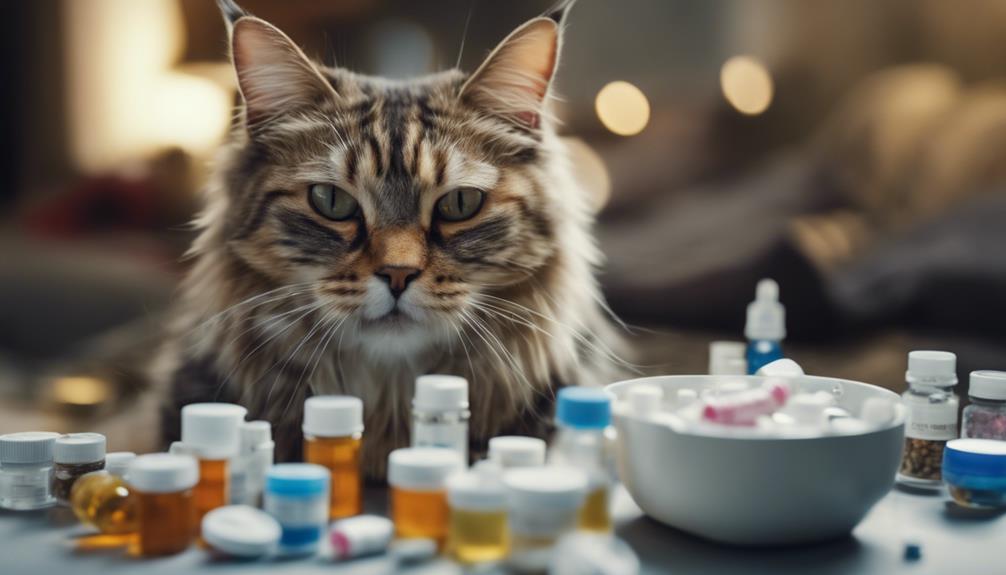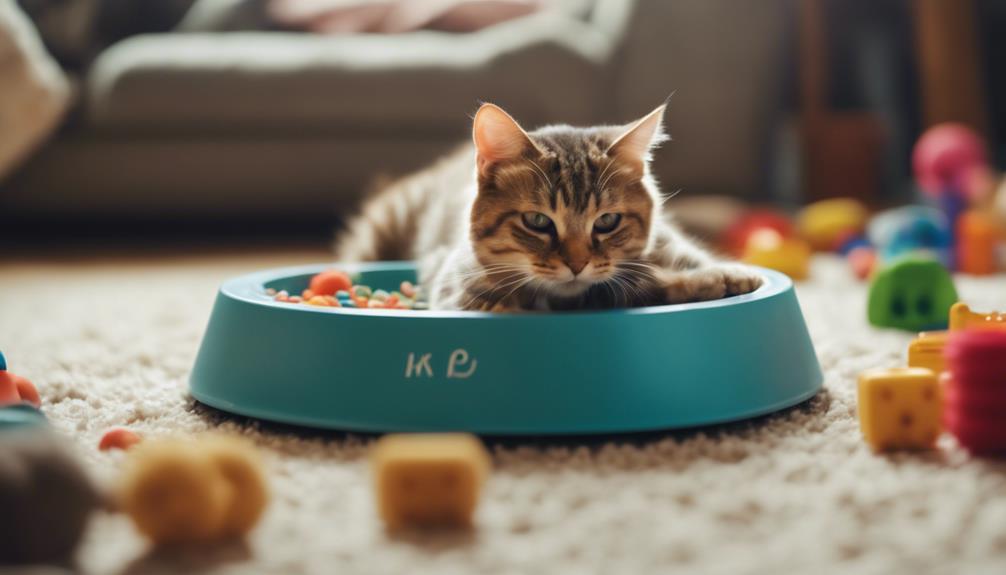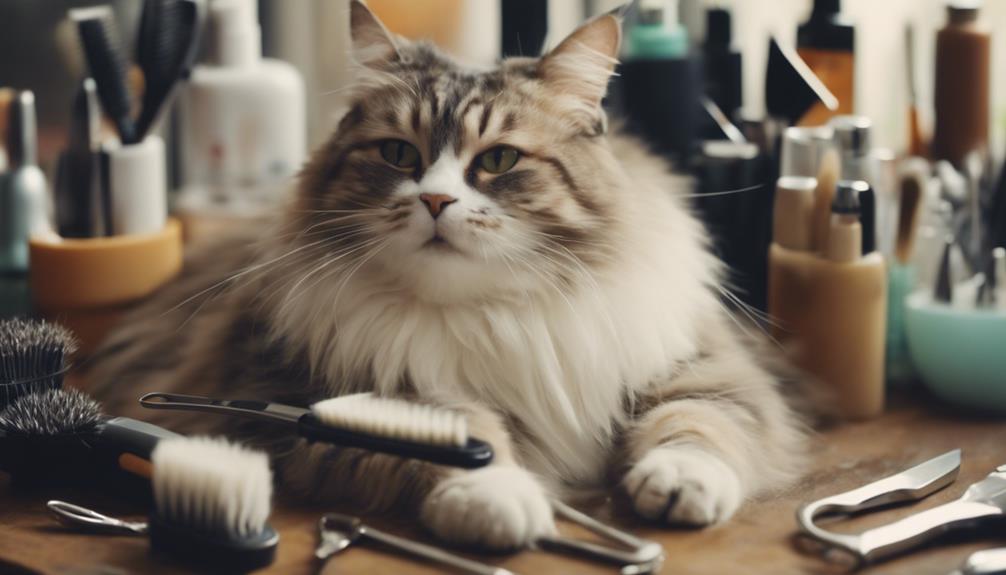In the realm of feline health, the occurrence of cat vomiting often prompts concern among pet owners. While occasional vomiting may be attributed to benign causes, understanding what constitutes normal behavior in cats and recognizing signs of potential health issues is crucial.
By exploring the intricacies of cat vomiting, this discussion will provide insights into differentiating between harmless instances and red flags that warrant veterinary attention.
Stay tuned to unravel the complexities of cat vomiting, gaining valuable knowledge to safeguard your feline companion's well-being effectively.
Key Takeaways
- Occasional vomiting is common in cats, often due to hairballs from grooming.
- Differentiate between acute and chronic vomiting based on frequency and accompanying symptoms.
- Monitor for signs like weakness, dehydration, or changes in behavior post-vomiting.
- Seek vet attention for frequent, colored vomit, or additional symptoms indicating underlying issues.
Common Causes of Cat Vomiting
Cat vomiting can be attributed to a range of common causes that cat owners should be aware of in order to gauge their feline friend's health. Some typical reasons for vomiting in cats include hairballs from grooming, food sensitivities, infections, and dietary indiscretions.
Understanding these triggers can help differentiate between harmless incidents and potential health concerns. While occasional vomiting is normal, chronic or severe episodes accompanied by other symptoms like lethargy, dehydration, or blood in vomit may indicate a more serious issue.
Monitoring your cat's vomiting habits and seeking veterinary attention when needed can ensure early detection and appropriate treatment, promoting your cat's well-being and comfort.
Differentiating Normal Vs. Abnormal Vomiting
Distinguishing between typical and concerning instances of vomiting in felines relies on recognizing accompanying symptoms and patterns. Understanding your cat's behavior is essential to differentiate between normal and abnormal vomiting. Below is a helpful guide to assist you in determining when your cat's vomiting may require veterinary attention:
| Symptom | Normal Vomiting | Abnormal Vomiting |
|---|---|---|
| Frequency | Occasional episodes, especially after grooming | Frequent and persistent vomiting |
| Vomit Content | Hairballs, undigested food | Blood, bile, or unusual colors in vomit |
| Additional Signs | No other symptoms present | Weakness, dehydration, or changes in behavior |
| Duration of Vomiting | Resolves quickly | Lasts for extended periods |
| Response to Treatment | Stops after a short time | Continues despite home care efforts |
Signs of Serious Health Issues

Identifying signs of serious health issues in cats involves vigilant observation of their behavior and physical condition. Look out for persistent vomiting, especially if it contains blood, bile, or foreign objects. Weight loss, lethargy, and changes in appetite or water intake can also indicate underlying problems.
Behavioral changes such as increased hiding, aggression, or vocalization may signal discomfort or distress. Physical signs like bloating, jaundice, or difficulty breathing should not be ignored. Additionally, if your cat shows signs of abdominal pain, dehydration, or weakness after vomiting, immediate veterinary attention is crucial.
Recognizing these red flags and acting promptly can help in diagnosing and addressing potential serious health issues in your feline companion.
Diagnostic Process for Vomiting in Cats
The diagnostic process for vomiting in cats involves a systematic approach to identifying the underlying cause through thorough examination and targeted testing. When a cat presents with vomiting, the veterinarian will conduct a physical exam to assess the cat's overall health and look for any visible signs of illness. This may include checking for dehydration, abdominal pain, or abnormal masses.
Additional tests such as blood work, x-rays, ultrasound, or fecal analysis may be necessary to pinpoint the specific cause of the vomiting. By carefully analyzing the cat's symptoms and running the appropriate tests, the veterinarian can determine the most effective treatment plan to address the underlying issue and help the cat feel better.
Treatment Options for Vomiting Cats

When addressing vomiting in cats, the focus shifts towards exploring effective treatment options to alleviate the distress experienced by feline companions. Treatment for vomiting cats depends on the underlying cause identified by a veterinarian.
Options may include dietary changes, medication to address inflammation or infection, or surgical intervention in severe cases. For cats with hairball-related vomiting, specialized diets or hairball remedies can be beneficial. Ensuring proper hydration through subcutaneous fluids or encouraging increased water intake is crucial.
In some instances, anti-nausea medications may be prescribed to provide relief. Owners play a vital role in the treatment process by following veterinary recommendations closely and creating a calm, stress-free environment for their furry friends during recovery.
Managing Vomiting at Home
To effectively manage vomiting in cats at home, owners can implement specific strategies to help reduce episodes and support their feline companions' well-being.
- Monitor Feeding Habits: Ensure your cat eats at a moderate pace with smaller, frequent portions to aid digestion and reduce the likelihood of vomiting.
- Maintain Hydration: Encourage your cat to drink water regularly to prevent dehydration, especially after vomiting episodes.
- Create a Calm Environment: Reduce stress triggers in your cat's environment, such as loud noises or sudden changes, to promote relaxation and minimize vomiting episodes.
Preventive Measures for Cat Vomiting

Regularly implementing preventive measures can significantly reduce the incidence of cat vomiting and promote your feline companion's digestive health. Here are some practical tips to help prevent vomiting in your cat:
| Preventive Measures | Description | Benefits |
|---|---|---|
| Gradual Diet Changes | Slowly transition to new foods to avoid upset stomachs | Minimizes digestive upsets |
| Moderate Feeding Pace | Offer small, frequent meals to prevent overeating | Reduces the chances of vomiting |
| Regular Grooming | Brush your cat regularly to reduce hairballs | Decreases hairball ingestion and vomiting |
| Avoid Dairy Products | Prevent potential lactose intolerance issues | Minimizes digestive discomfort |
Importance of Diet and Feeding Habits
An optimal diet and appropriate feeding habits are crucial factors in maintaining a cat's digestive health and preventing episodes of vomiting.
- Quality Nutrition: Providing a well-balanced diet tailored to your cat's age, breed, and health needs is essential for digestive function and overall well-being.
- Regular Feeding Schedule: Establishing a consistent feeding routine helps regulate digestion and reduces the likelihood of overeating or rapid consumption, which can trigger vomiting.
- Hydration: Ensuring an adequate water intake is vital for digestion and preventing dehydration, especially for cats prone to vomiting. Consider incorporating wet food or a drinking fountain to encourage hydration.
Role of Regular Grooming in Vomiting Prevention

Regular grooming plays a crucial role in preventing vomiting episodes in cats by reducing the incidence of hairballs and promoting overall digestive health. Grooming helps remove loose fur, preventing excessive ingestion during self-cleaning sessions that can lead to hairballs and subsequent vomiting. It also stimulates blood circulation and the secretion of natural oils, benefiting skin health. Ensuring your cat's coat is free of tangles and mats through regular grooming sessions can significantly reduce the chances of hairballs forming and causing discomfort or vomiting episodes. Below is a table highlighting the benefits of regular grooming in preventing vomiting:
| Benefits of Regular Grooming in Vomiting Prevention | |
|---|---|
| Reduces hairball formation | Promotes skin health |
| Prevents ingestion of excessive fur | Stimulates blood circulation |
| Improves overall digestive health |
Ensuring a Safe Environment for Cats
Maintaining a secure environment for cats is paramount in safeguarding their well-being and preventing exposure to potential hazards.
- Eliminate Toxic Substances: Keep household cleaners, plants, and medications out of reach to prevent accidental ingestion.
- Safe Hideaways: Provide hiding spots like cat trees or shelves to offer security and reduce stress.
- Secure Windows and Balconies: Install window screens and balcony enclosures to prevent falls and injuries.
Frequently Asked Questions
Can Stress or Anxiety Play a Role in Causing Cats to Vomit?
Stress or anxiety can trigger vomiting in cats. Emotional upheavals can disrupt their digestive system, leading to episodes of vomiting. Monitoring and managing stressors, along with consulting a vet for appropriate interventions, can help alleviate this issue.
Are There Any Natural Remedies or Supplements That Can Help Alleviate Cat Vomiting?
Natural remedies or supplements like probiotics, digestive enzymes, or herbal remedies may help alleviate cat vomiting. However, consult a veterinarian before administering any new treatment to ensure it's safe and effective for your cat's specific condition.
How Can a Cat Owner Differentiate Between Vomiting and Regurgitation in Cats?
Differentiating between vomiting and regurgitation in cats involves noting the presence of bile or food in vomit, with regurgitation expelling undigested food. Vomiting is an active process, often accompanied by retching and abdominal contractions, indicating a more complex issue requiring veterinary attention.
Can Certain Breeds of Cats Be More Prone to Vomiting Than Others?
Certain cat breeds, such as Siamese or Himalayans, may be more prone to vomiting due to their predisposition to conditions like gastroenteritis or hairball issues. Understanding breed-specific tendencies can help owners anticipate and manage vomiting episodes effectively.
Is There a Link Between a Cat's Age and the Likelihood of Experiencing Vomiting Episodes?
The likelihood of cats experiencing vomiting episodes can increase with age due to factors like dietary changes, reduced digestive efficiency, or underlying health conditions. Regular monitoring, appropriate diet adjustments, and prompt veterinary care are essential for senior cats.
Conclusion
In conclusion, understanding the causes, signs, and diagnostic processes for cat vomiting is crucial for cat owners to ensure their feline companions' well-being.
By differentiating between normal and abnormal vomiting, implementing preventive measures, and seeking appropriate treatment when necessary, individuals can promote their cats' gastrointestinal health and overall quality of life.
With a proactive approach to managing cat vomiting, owners can create a safe and healthy environment that supports their cats' long-term wellness.




